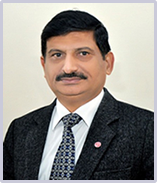
Dr. Anil Sirohi
Director Research
0121-2888504
Message
With the inception of the university on 2 nd October 2000, the Directorate of Experiment Station was also established. A strong research and development activities of an organization may leads it to the highest core of its achievements. In order to attain the national and international status, an organization must equip itself physically, technically and financially to deliver the goods to the nation for the welfare of its inhabitants. Research scientists need to keep abreast with the developing scenario of research and development globally. To achieve desired and expected outcome, all the research centres and units need to be modernized with latest technical equipments and knowledge.
Agro Climatic Zones
Characteristic features of agroclimatic zones falling under university operational area: -
1. Bhabhar and Tarai Zone:
Just below the foot hills of Himalayas, a narrow strip of land is known as Bhabhar which covers part of Saharanpur and Bijnore districts of the state. Tarai comprises of the central part of Saharanpur district, northern portion of Bijnore, Moradabad, Rampur, Barielly, Pilibhit and Shahjahapur. Temperature vary from 4.30C to 38.40C with R.H. 39% in May to 81.7% in July. Average rainfall is 1400 mm. Soil is alluvial in nature, low to medium in phosphorus, medium to high in potassium and high in organic matter. The main crops of the area are wheat and rice. Gram and lentil are the major pulses while rapeseed and mustard occupy the principal position as oilseed crops. Potato, tomato, cole crops, vegetable pea and cucurbits are among the vegetable for the area and mango, guava, litchi, papaya are the major fruits being grown in this zone.
2. Western Plain Zone:
This zone is highly productive with light loam soil situated between the Ganga and Yamuna rivers and their tributaries. This zone includes districts of Meerut, Baghpat, Muzaffarnagar, Ghaziabad, Gautam Budh Nagar, Bulandshahr and part of Saharanpur. Average annual rainfall is 795 mm, R.H. ranges from 32 to 85% and temperature vary from 1.50C to 43.20C. Cropping system of the zone oscillate around Sugarcane. Major crops of the zone comprise of sugarcane, wheat, rice, maize, bajara, blackgram, chickpea, groundnut and mustard. Potato, onion, tomato, pea, cole crops, chillies are the major vegetables and mango, litchi, grape, guava and papaya are the major fruit cultivated in the zone. Floriculture is also practiced in this zone.
3. Mid Western Plain Zone:
This zone comprised of the districts of Badaun, Shahjahanpur. J.P. Nagar and part of Moradabad, Rampur, Bareilly and Pilibhit. Average annual rainfall is 1032 mm and the temperature ranges from 4.50C to 45.40C. The soil of the region is mostly alluvial. Soils are neutral to moderately alkaline having medium organic matter. Wheat, rice, sugarcane, bajra, Sorghum, maize, groundnut, rape-seed and mustard, gram, peas, lentil, urd, pigeon pea are the major field crops. Potato, brinjal, cauliflower are the major vegetable crops. Mentha cultivation is also being practiced in this zone at large scale.
Major Thrust Areas
- Developing precision irrigation systems requiring low volume of water.
- Developing technology for sustainable improvement of soil health and fertility with bias on organic components.
- Emphasizing organic farming technology in prevailing crop production systems.
- IPNM and IPM technology of combating soil health and pests problems.
- Strengthening fruits, vegetables, floricultural, herbal and spices research activities.
- Promoting entrepreneurship vocations trade like poultry, mushroom, sericulture, apiculture, fisheries, piggery, goatary and dairying for diversification based agriculture.
- Post harvest technology and value addition of the crop produce for export purposes.
- Promoting aromatic and medicinal plants and floriculture for developing entrepreneurship for export.
- Development of programmes for improvement of buffalo, cattle and sheep.
Infrastructure
Directorate of Research is running in the separate building in which research units are running under the supervision of Directorate of Research i.e. CRC, HRC, LRC, PRTC, Chirodi Farm, Seed Production Centre and Zonal Research Centres viz. Nagina, Bulandshahr and Ujhani.
Seed Production Centre
The university is producing and supplying quality seeds to the farmers and other organizations as per area specific needs and from seed sale the total income was generated in the year 2015-16 is as under.
Kharif 2015 Intake, Processed Quantity and Seed Sale
| S. No. |
Crop |
Varity |
Class of Seed |
Intake Oty. (Qtl) |
Processed Qty. (Qtl) |
Sale Qty. (Qtl) |
Rate (Per Kg.) |
Amount (Rs.) |
| 1 |
Urd |
PU-31 |
C/S |
20.00 |
15.66 |
15.51 |
110.00 |
170610.00 |
| PU-40 |
C/S |
10.15 |
7.10 |
5.45 |
110.00 |
59950.00 |
| 2 |
Moong |
PU-5 |
F/S |
21.0 |
15.60 |
Failed |
Failed |
Failed |
| Total |
|
51.50 |
38.36 |
20.96 |
|
230560.00 |
| S.No. |
Crop |
Variety |
Class of Seed |
Intake Qty. (Qtl) |
Processed Qty. (Qtl.) |
Sale Qty. (Qtl.) |
Rate (Per Kg.) |
Amount (Rs.) |
| 1 |
Paddy |
PB-1509 |
F/S |
23.42 |
13.90 |
12.06 |
66.00 |
79596.00 |
| T/ |
88.95 |
53.55 |
51.10 |
63.00 |
321930.00 |
| 2 |
Paddy |
VB-21 |
F/S |
52.62 |
23.80 |
0.00 |
66.00 |
0.00 |
| B/S |
6.28 |
3.75 |
0.00 |
100.50 |
0.00 |
| 3 |
Paddy |
VB-22 |
F/S |
16.90 |
7.58 |
0.12 |
66.00 |
792.00 |
| B/S |
9.53 |
3.15 |
0.00 |
100.50 |
0.00 |
| 4 |
Paddy |
PB-1 |
F/S |
393.56 |
248.23 |
68.38 |
66.00 |
451308.00 |
| C/S |
155.68 |
103.14 |
0.10 |
63.00 |
630.00 |
| 5 |
Paddy |
PS-5 |
F/S |
714.87 |
440.50 |
106.25 |
63.00 |
669375.00 |
| C/S |
164.86 |
98.88 |
0.45 |
58.00 |
2610.00 |
| TOTAL |
|
1626.67 |
996.48 |
238.46 |
|
1526241.00 |
| GRAND TOTAL |
1678.17 |
276.82 |
259.42 |
|
1756801.00 |
Rabi 2015-16 Processed Quantity and Seed Sale
| S.No. |
Crop |
Variety |
Class of Seed |
Intake Qty. (Qtl) |
Processed Qty. (Qtl.) |
Sale Qty. (Qtl.) |
Rate (Per Kg.) |
Amount (Rs.) |
| 1 |
Wheat |
PBW-550 |
C/S I |
326.42 |
|
|
|
|
| 2 |
Wheat |
PBW-226 |
F/S II |
366.82 |
|
|
|
|
| 3 |
Wheat |
WH-711 |
F/S II |
159.45 |
|
|
|
|
| 4 |
Wheat |
DBW-17 |
F/S II |
601.24 |
|
|
|
|
| 5 |
Wheat |
PBW-590 |
F/S II |
68.64 |
|
|
|
|
| C/S I |
309.00 |
|
|
|
|
| TOTAL |
|
1831.57 |
|
|
|
|
| S.No. |
Crop |
Variety |
Class of Seed |
Intake Qty. (Qtl) |
Processed Qty. (Qtl.) |
Sale Qty. (Qtl.) |
Rate (Per Kg.) |
Amount (Rs.) |
| 1 |
Mustard |
P.Bold |
T/L |
9.36 |
|
|
|
|
| TOTAL |
|
9.36 |
|
|
|
|
| GRAND TOTAL |
1840.93 |
|
|
|
|
Livestock Research Centre
University has a well developed live stock research centre where different scientist of animal science department and veterinary college along with students conducting their research work on specialist field to generate the technology related to the improvement of breed of cow and buffalo for higher milk yield. The milk produce from the LRC sale among the staff and students not only fulfill the milk requirement of the staff and student but also a good source of income for the further research work.
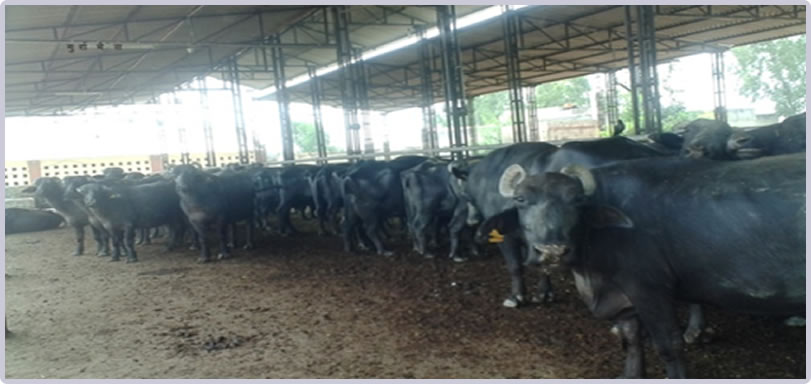
Murrah Buffalo herd
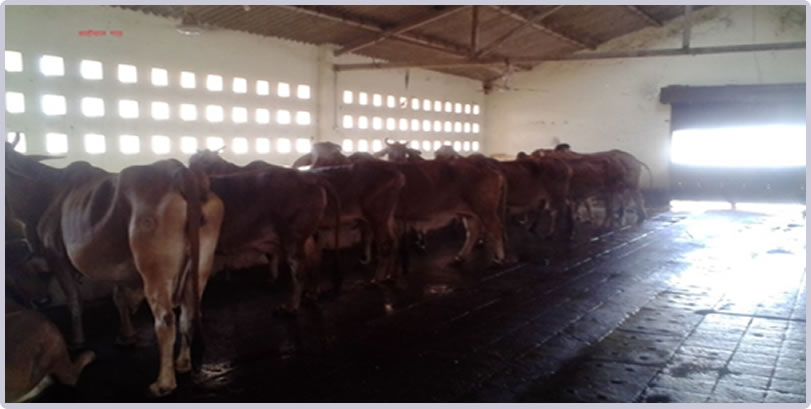
Sahiwal cow herd
Crop Research Centre
University has 9.9 ha land at its Crop Research Center (CRC) located at Chirodi which has been divided into different blocks for different agricultural discipline where scientist and students conduct the trial/experiments on various aspects of different crops for generation of location specific, client oriented and need based technology for the farmers of the area jurisdiction of the university. The proved technology/recommendations transfer to the farmers directly by the scientists/Directorate of Research or through the Directorate of Extension. Apart from this a sizable number of farmers visiting these trials/experiments while the visiting the University.
Horticulture Research Centre
Horticulture Research Center (HRC) of the university divided in to two blocks situated at old building and at main campus (Siwaya block). Both blocks having the total area of 12.21 ha. Out of these the area under orchard is 5.78 ha., open area for other experiments is 2.1 ha., area under herbal and medicinal garden is 1.46 ha and the rest 2.87 ha area is under buildings, roads, irrigation channels etc.
Major crops under experimentation:
Fruits: Mango, Guava, Litchi, Bael, Aonla, Jamun, citrus, Papaya, Grapes, Peach etc.
Vegetables and Medicinal/Aromatic Plants: Solanacious, Crucifereae, Cucurbits, Spices & Medicinal and Aromatic Plants.
Flowers: Gladiolus, Marigold, Chrysanthemum etc.
Seed Production: Produced and distributed quality seed of coriander
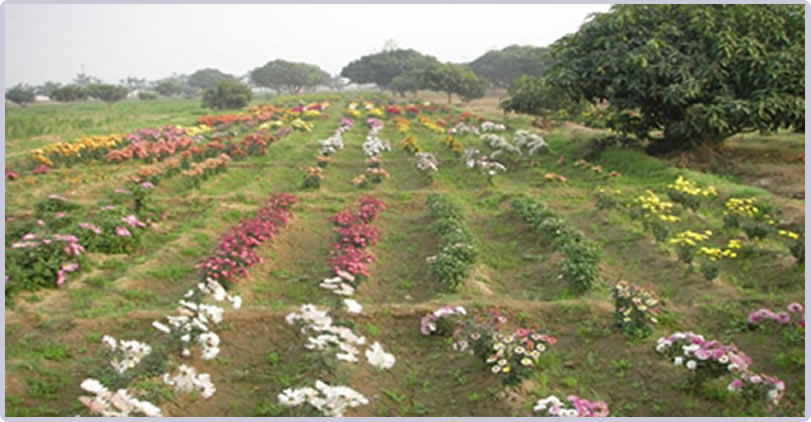
Varietal Trial on floriculture crop (Chrysanthemum)
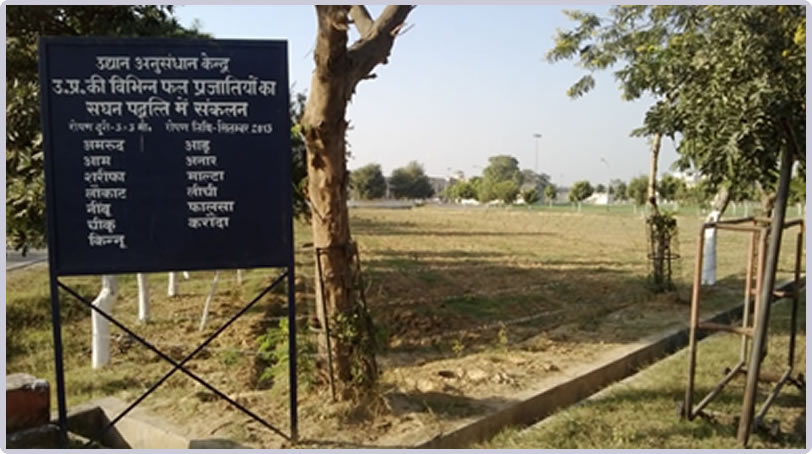
Established high density orchard of different fruit crops
Inter Institutional Link
Directorate of Research has well institutional linkage with state department of agriculture, state department of Horticulture, U.P. Agro, U.P. Seed Corporation, National Seed Corporation, IFFCO, KRIBHCO and central research institute such as CPRI, IIFSR and PDC.
MoU With NIPGR PDF 
Research Stations
Zonal Research Stations: University has three zonal research stations in its jurisdiction area.
1. Zonal Research Station- Nagina
Research Station Nagina is one of the premier Rice Research Station of the country which was established by British Govt. after intensive survey of undivided India in 1921., situated in foot hills of great Himalaya at an altitude of 29O 28' North , and latitude 78o 32' East at 245 meter above mean sea level. This station has released 24 rice varieties for different eco-systems before green revaluation era and some of them are still under cultivation. An export quality rice variety Type -3, known as Dehraduni Basmati, is the first variety by which the quality rice export was started first time by our country India, was also released by this station. Another rice variety N-22, a drought resistant variety, is still being used as donor parent for drought resistant breeding. ICAR funded AICRP on rice is also running at Nagina . Some of major achievements along with staff position are summerized below
Staff Position
| S.No. |
Name |
Designation |
| 1 |
Dr. Rajendra Singh |
OIC, ZRS Nagina |
| 2 |
Dr. Vivek Yadav |
Jr. Agronomist( AICRP) |
| 3 |
Sh. Rajeev Rana |
Field Assistant( AICRP) |
2. Zonal Research Station- Bulandshahr
The Research Station was established in 1905 by the Department of agriculture as a Seed Production farm. This was converted into a research station in 1944 with the following main objectives:
- Maintainence of germplasm of American indigenous cotton.
- Cotton variety BH-7 found suitable for spring planting. Its proposal sent for the release.
- Produced and distributed the seed of rice, wheat, berseem, arhar and maize crop.
Staff Position
| S.No. |
Name of Staff |
Designation |
Duties Assigned |
| 1 |
Dr. Shiv Singh |
Prof.(Agronomy) and OIC |
Scientific work and also bearing the responsibilities as officer-in charge |
| 2 |
Shri S.K.Yadav |
Field Assistant |
Field work like Seed production |
| 3 |
Shri Puran Singh |
Senior Assistant |
Store (Seed & Grain) Seed Processing work, Seed Sale etc. |
3. Zonal Research Station -Ujhani
Zonal Research Centre comes in the Mid-Western Plain Zone of Uttar Pradesh which falls in between 27º 60′ and 29º 50′ N Latitude and 78º and 80º 40′ S Longitude of the State. The altitude in this region varies between 150-300m. The Ganges flow from North to South in the west part of this Zone & separates it from western plain zone. This zone comprises an area of 30.50 thousands square kilo meter, being third largest region of Uttar Pradesh, accounts for 10.50 per cent of the total reported area under land utilization of the state. The Agro climatic conditions of this zone are dry and warm. Soils are mostly alluvial and neutral to moderately alkaline in reaction with low to medium in organic contents. Average rainfall of this region ranges from 650 mm to 1,600 mm and district Budaun receives minimum rainfall.
Almost 90 per cent of rainfall is concentrated in four months from mid June to mid October which is variable and erratic. In this zone tube wells and canals are the major sources of irrigation but larger area is irrigated through tube wells except Bareilly district. Budaun has the least area under irrigation i.e. approx 44 per cent.
Staff Position
| S.No. |
Name |
Designation |
| 1 |
Dr. S.B. Singh |
OIC, Res. St. Ujhani |
| 2 |
Dr. A.K. Chaubey |
Assoc. Prof., Soil Science |







